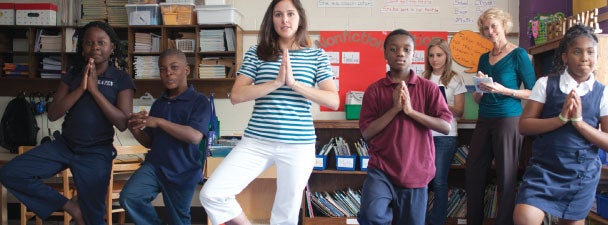
The students slowly breathe in, then out. They pick a point against the classroom wall at which to stare and focus their attention. Exhaling, they lift, in unison, their right legs and rest their feet on the calf of their left legs. A few cut glances at their teacher to see how she’s doing. They then slowly raise their hands together to form a namaste, the customary greeting in Indian culture. There’s no giggling as they hold that position, just breathing – and perhaps the slightest sound of pen on paper as someone scribbles notes in the back of the classroom.
That someone is Lauren Rose ’12 (M.Ed.), a student in the College’s science and math for teachers program and a graduate assistant to teacher education professor Christine Finnan. She’s collaborating with Finnan on the research of a school-wide yoga program at Mitchell Math and Science Elementary School, just two miles from campus in downtown Charleston.
“I do yoga,” Finnan says, “so when I heard about a high-poverty school incorporating yoga instruction from kindergarten to fifth grade, I thought that program sounded cool, and I wanted to do a qualitative study on its general effect.”
For Rose, the research project was especially intriguing since it gave her an opportunity to get back into the classroom environment.
“When you’re a grad student in education,” Rose explains, “you’re already certified to teach, so you don’t spend much time in an actual classroom with kids. You’re focused on content and instruction techniques. Plus, in most places, grad assistants are usually tasked with making copies and running errands. With Professor Finnan, I had the chance to do a kind of research I wasn’t used to – qualitative, rather than quantitative – focusing on the why, not the how.”
For two years, Rose, along with several anthropology undergraduate students, served as participant observers. They spent an hour in the class before the yoga lesson and then another hour after the lesson, recording observations on student behavior and focus.
“We noticed that kids were more calm and alert after yoga,” Rose says, “and we learned in our interviews with them that yoga had given them another tool to help them deal with stressful situations in their lives. A lot of kids told us that they do yoga at home when they’re upset with their parents or siblings. Basically, it gives them a tool to regulate their emotions.”
While neither Finnan nor Rose believes that yoga is some kind of magic bullet for fixing schools, they did learn that behavioral referrals decreased, and they observed students making strong connections with their teachers who participated in the yoga instruction with them.
Rose also made a strong connection with the teacher of the third-grade class she observed. Melissa Nehez ’06, who is the school’s 2011-12 Teacher of the Year, leads an academy class of 14 students, working with them an extra hour at the end of the day.
“I’ve really benefited from watching Melissa, an amazing teacher,” Rose says. “She’s definitely been a mentor to me, and has helped shape the approach I want to take in my own classroom.”
And although Rose isn’t a devotee to yoga like Finnan or Nehez, “I do plan to incorporate yoga into my own classroom,” Rose admits. “The benefits to a student’s sense of belonging, engagement and accomplishment are too numerous to ignore. Yoga clearly makes a difference.”
Photos by Gately Williams





